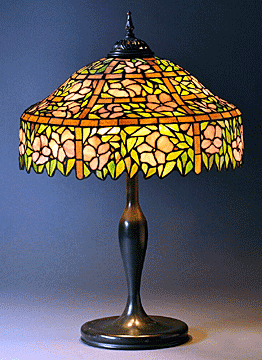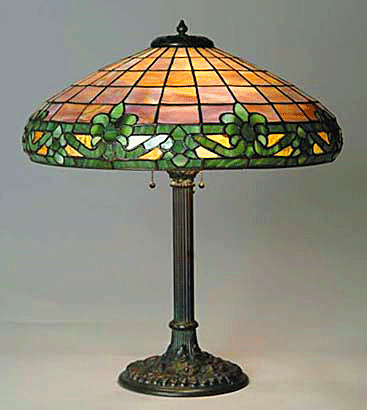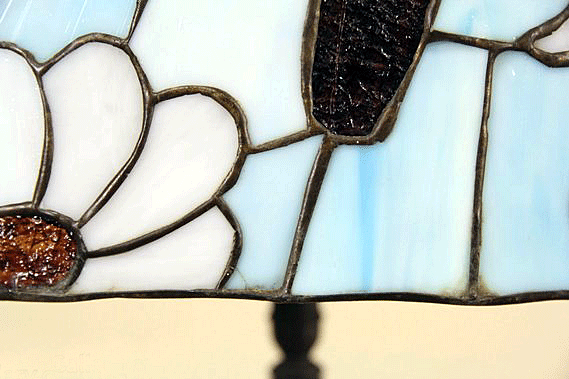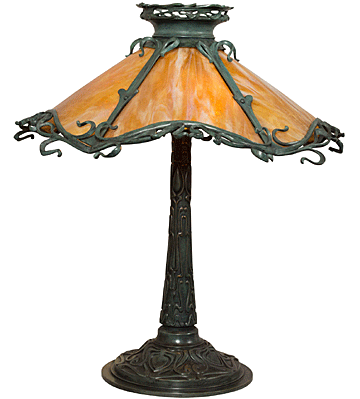Sorting Out Early Stained Glass Lamps
by Bob Brooke
 Between 1895 and 1915, a huge variety of mosaic glass lamps came out of
New York and Chicago to satisfy a growing demand for stylish lighting
designs. While Tiffany Studios set the industry standard, other
companies produced excellent designs as well. So while Tiffany made all
his lamp shades of stained glass, Tiffany Studios wasn’t the only
company to make stained glass lamps. Between 1895 and 1915, a huge variety of mosaic glass lamps came out of
New York and Chicago to satisfy a growing demand for stylish lighting
designs. While Tiffany Studios set the industry standard, other
companies produced excellent designs as well. So while Tiffany made all
his lamp shades of stained glass, Tiffany Studios wasn’t the only
company to make stained glass lamps.
Electricity, the new energy source that would soon sweep the country,
demanded a new type of lamp, one that would shield the viewer from the
harsh glare of the early incandescent bulbs and at the same time add
Victorian beauty to a room. It was the mid-1890s and the Victorians
weren’t ready just yet to give up their lavish designs, so Louis Comfort
Tiffany worked with that and developed lamps in the avant garde Art
Nouveau style that complemented the decor present in middle class and
upper middle-class homes of the day.
 Companies such as Duffner & Kimberly and Gorham made lamps of a quality
that compared with those made by Tiffany Studios. They created styles
that appealed more to the prevailing Victorian taste. Some companies,
like Wilkinson, made high-quality bases, but took short cuts with their
shades. Others, like Unique, focused on creating complex shades and
paired them with simpler bases. Many copied Tiffany’s Art Nouveau
designs and many copied each other which creates a challenge for
collectors trying to identify their lamps. Companies such as Duffner & Kimberly and Gorham made lamps of a quality
that compared with those made by Tiffany Studios. They created styles
that appealed more to the prevailing Victorian taste. Some companies,
like Wilkinson, made high-quality bases, but took short cuts with their
shades. Others, like Unique, focused on creating complex shades and
paired them with simpler bases. Many copied Tiffany’s Art Nouveau
designs and many copied each other which creates a challenge for
collectors trying to identify their lamps.
So how do you tell the difference between authentic Tiffany lamps and
those made by these other companies? Most of the time it’s difficult.
Learning how to spot the best lamps could take years of study because
many lamp manufacturers didn’t sign their pieces, and the differences
are often subtle between a quality lamp from this period and a modern
reproduction. You also have to keep an eye out for “made-up” lamps,
composed of both old and new parts. But there are a few things you can
look out for.
Tips for Authenticating Early Stained
Glass Lamps
 Look for hairline cracks in the glass.
It isn’t unusual for hairline cracks to appear in the panes of old
stained glass shades. This is the natural result of the glass expanding
and contracting as it heats and cools when someone turns the lamp on and
off. In fact, a lamp that doesn’t have any “stress” or “heat” cracks may
be of more recent construction. Look for hairline cracks in the glass.
It isn’t unusual for hairline cracks to appear in the panes of old
stained glass shades. This is the natural result of the glass expanding
and contracting as it heats and cools when someone turns the lamp on and
off. In fact, a lamp that doesn’t have any “stress” or “heat” cracks may
be of more recent construction.
Pay attention to glass color. Look
at the colors of the glass pieces. Are they subtle, gaudy, bright, or
soft? Overall, the colors should match in tone and intensity. If the
shade has a “Crayola crayon” look to it—with overly bright, gaudy, or
clashing colors—it could be of more recent construction, or have had
some panes replaced.
 Pick up the base and feel the weight.
Although the quality of workmanship and materials can vary greatly on
these lamps, the best lamp bases are heavy and well-cast. Finer lamps
will have cast brass or bronze finials and bronze bases. Pick up the base and feel the weight.
Although the quality of workmanship and materials can vary greatly on
these lamps, the best lamp bases are heavy and well-cast. Finer lamps
will have cast brass or bronze finials and bronze bases.
Step back and gauge the overall design.
The shade and base should not only fit together properly, but there
should be an overall sense of balance between all the design elements,
from the finial to the base plate. The shades should have some complex
elements of design or thoughtful use of color. The overall design should
be crisp and clean.
Lastly, talk to a reputable dealer or
appraiser. A reputable dealer or appraiser who specializes in
early 20th-century lamps will be familiar with these lamps and their
characteristics and will be able to help you identify a lamp you own.
Antique Tiffany lamps remain the golden standard of mosaic glass
lighting. However, don’t ignore well-designed, handcrafted, beautiful,
and very collectable antique mosaic lamps from a wide variety of other
manufacturers.
< Back to Collecting Archives
Next Article > |
